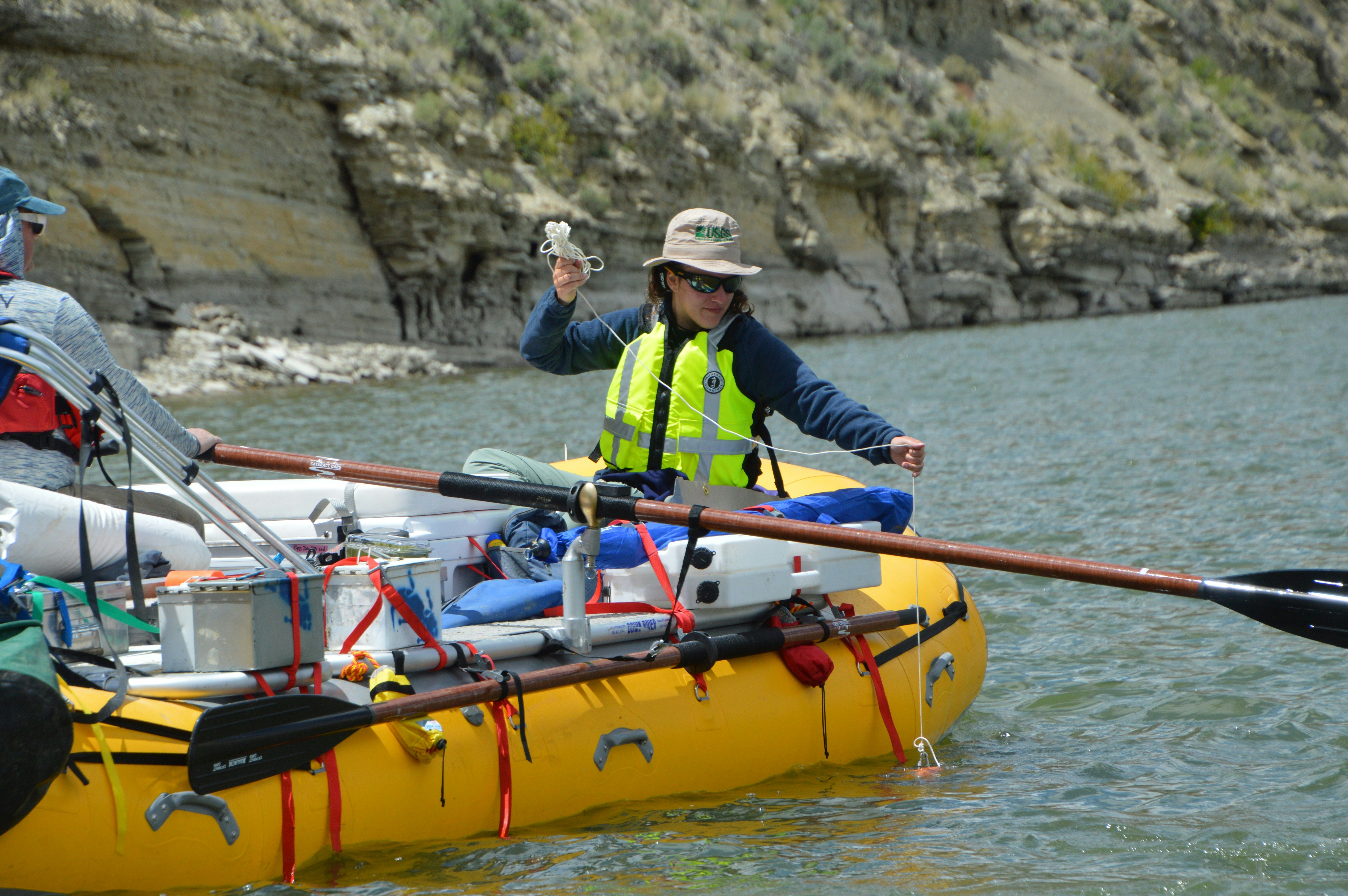How To Become an Environmental Scientist for 2026
The environment is at risk as the levels of pollution continue to rise on a global scale. In the United States, one in four individuals resides in an area with an unhealthy level of air pollution. There is a professional trained to protect the natural environment and have solutions to reduce pollution levels, preserve animal populations, and restore deforested areas—the environmental scientist.
This guide provides an easy-to-follow instructional on how to become an environmental scientist and delves into the professional's key skills and responsibilities. It also offers information that aspiring environmental scientists need to know, like potential certifications, salary projections, job outlook, and possible career paths.
Key Things You Should Know About Becoming an Environmental Scientist
- Environmental scientists apply scientific principles to protect the environment and human health.
- The US states that employ the most environmental scientists are California (12,590), Florida (5,210), Washington (4,100), North Carolina (3,940), and New York (3,680).
- Becoming an environmental scientist requires a combination of education and hands-on experience, typically spanning four to six years.
- 81% of environmental scientists earned a bachelor's degree.
- The employment of environmental scientists is projected to grow by 7% from 2033 to 2033.
- The average annual salary of environmental scientists in the United States is $86,710, while their median annual salary is $78,980.
Table of Contents
- What does an environmental scientist do?
- How does one become an environmental scientist?
- How long does it take to become an environmental scientist?
- How does a student find an internship in environmental science?
- What key skills should an environmental scientist possess?
- What are the best certifications for environmental scientists?
- How can I manage the cost of my environmental science education?
- What are the emerging trends in environmental science careers?
- Is an online associate degree a viable stepping stone for advancing in environmental science?
- How can environmental scientists maximize career advancement?
- What are the best continuing education resources for environmental scientists?
- What are the possible career paths of aspiring environmental scientists?
- What is the job outlook for environmental scientists?
- What is the average salary of environmental scientists?
- What are the biggest challenges faced by environmental scientists today?
- How do advanced degrees enhance long-term career prospects in environmental science?
- How can professional networking accelerate career growth in environmental science?
- Are online degrees a credible pathway to a successful career in environmental science?
- How Do Environmental Scientists Influence Public Policy and Decision-Making?
- Other Things You Should Know About Becoming an Environmental Scientist
What does an environmental scientist do?
Environmental scientists apply scientific principles to protect the environment and human health. They investigate environmental problems, collecting and analyzing data from various sources like soil, water, and air. Their work involves assessing pollution levels, studying ecosystems, and developing strategies for sustainable practices. They communicate their findings to inform policy decisions, guide business practices, and educate the public. By specializing in areas such as climate change or waste management, they contribute to building a healthier future.
Their key responsibilities include the following:
- Conduct Research and Investigations: They study environmental issues such as pollution, climate change, resource management, and conservation. This often involves collecting and analyzing data from various sources like air, water, soil, and biological samples.
- Identify and Assess Environmental Problems: They analyze data to pinpoint sources of pollution, assess risks to human health and ecosystems, and evaluate the impact of human activities on the environment.
- Develop Solutions and Recommendations: Based on their findings, they propose solutions to environmental problems, develop strategies for conservation and sustainability, and advise policymakers, businesses, and communities on best practices.
- Monitor Environmental Conditions: They track environmental changes over time, monitor the effectiveness of environmental policies and regulations, and assess the impact of natural events and human activities.
- Communicate Findings: They present their research findings through reports, presentations, and publications to inform decision-making and raise public awareness about environmental issues.
Based on the 2024 data of the United States Bureau of Labor Statistics (BLS), the states that employ the most environmental scientists, as seen on the chart below, are California (12,590), Florida (5,210), Washington (4,100), North Carolina (3,940), and New York (3,680).
How does one become an environmental scientist?
Learning how to become an environmental scientist begins by earning an undergraduate degree—preferably in environmental science or a closely related field—and pursuing an internship or volunteer work. Graduates can obtain certifications to boost their expertise and employability. To illustrate a clearer view, here's a simple step-by-step guide that aspirants can follow:
- Earn a Relevant Degree: A bachelor's degree in environmental science, biology, chemistry, geology, or a related field is typically required. Coursework in ecology, environmental policy, and data analysis provides a strong foundation for this career. Being an environmental scientist is also one of the best careers to pursue with a sustainability management degree.
- Gain Practical Experience: Hands-on experience through internships, volunteer opportunities, or research projects is essential. Practical experience in fieldwork, such as soil and water sampling, helps develop critical skills and makes you more competitive in the job market.
- Consider Advanced Education: A master’s or doctoral degree can open doors to specialized roles in research, policy development, or teaching. Advanced education provides deeper expertise in areas like climate change, environmental law, or ecological restoration. Those who intend to become more proficient in data analytics can pursue online data science programs.
- Obtain Certifications: Professional certifications relevant to environmental science, such as the Certified Environmental Scientist (CES) or Leadership in Energy and Environmental Design (LEED), underscore expertise and commitment to industry standards, enhancing a scientist's career prospects.
- Develop Technical Skills: Proficiency in Geographic Information Systems (GIS), environmental modeling, and data analysis is highly valued. Understanding environmental regulations and compliance requirements is also crucial for many roles.
- Stay Updated and Network: Joining professional organizations like the National Association of Environmental Professionals (NAEP) or attending industry conferences helps stay informed about trends and job opportunities while building valuable connections.
- Seek Employment Opportunities: Environmental scientists can work in government agencies, consulting firms, non-profits, and research institutions. A well-rounded resume with a mix of education, experience, and technical skills is key to landing a job in this field.
If biochemistry is your science of choice, you can get the best online biochemistry degree for you bachelor's and get certifications or a master's degree that are more focused on environmental science.
How long does it take to become an environmental scientist?
Becoming an environmental scientist requires a combination of education and hands-on experience, typically spanning four to six years. A bachelor's degree, earned over three to four years, provides the core scientific knowledge and understanding of environmental systems. The subsequent one to two years of practical experience, often gained through internships and entry-level jobs, is invaluable for applying these principles in real-world scenarios.
For those seeking deeper expertise and advanced career opportunities, a master's degree, adding one to two years of focused study, provides a significant advantage. However, a graduate degree is not necessary to become an environmental scientist. Meanwhile, those who intend to pursue a graduate program can take easy masters degrees online.
According to 2025 data from Zippia, 81% of environmental scientists earned a bachelor's degree, 12% have a master's degree, 5% earned an associate degree, and 1% have a doctorate degree.

How does a student find an internship in environmental science?
Like budgeting for an LPN training cost, finding an internship in environmental science can be a strategic process. There are various avenues to find possible internships. This activity is essential for aspirants since internships simulate the actual jobs of environmental scientists, enabling them to develop job skills. Here are some effective methods for students to secure opportunities in this field:
- Utilize Online Job Boards: General job sites like Indeed and specialized environmental platforms frequently list internship opportunities. Students can search using keywords such as "environmental science internships" and refine their search by location, keywords, and interests.
- Network and Build Connections: Connecting with professors, industry professionals, and fellow students can create valuable networking opportunities. Joining professional environmental organizations and attending relevant conferences can also lead to internship prospects through networking events.
- Explore University Career Services: Many universities offer career centers with resources for internship searches, including online job boards, resume and cover letter workshops, and mock interview preparation. Students should utilize these services to strengthen their applications.
- Engage in Direct Outreach: Students can proactively contact companies and organizations of interest, even if they haven't advertised specific internships. Sending a personalized email expressing their interest in potential opportunities can sometimes result in positive responses.
- Explore Remote and International Options: For students interested in remote work or international experiences, various organizations offer internships focused on environmental conservation and global sustainability. Platforms like Intern Abroad HQ provide resources for finding and applying to international internships.
What key skills should an environmental scientist possess?
Environmental scientists possess a broad but concentrated skillset that allows them to effectively investigate scenarios, gather data, and produce appropriate solutions. They are excellent researchers, proficient problem solvers, and adept communicators. Here are their most critical skills:
- Analytical and Critical Thinking Skills: Environmental scientists rely on analytical and critical thinking to address complex environmental challenges. This involves interpreting data, identifying patterns, and developing logical, science-based strategies for sustainable solutions.
- Research and Data Analysis Skills: Conducting field and laboratory research is a core aspect of environmental science. Scientists must be skilled in collecting, processing, and interpreting data using statistical and scientific methods to draw accurate conclusions.
- Technical and Laboratory Skills: Proficiency in using scientific equipment, environmental monitoring tools, and lab techniques for sampling and testing air, water, and soil quality is essential for accurate environmental assessments.
- Geographic Information Systems (GIS) and Remote Sensing: GIS and remote sensing skills are valuable for spatial analysis, environmental mapping, and modeling environmental changes, helping to visualize data for effective decision-making.
- Environmental Regulations and Compliance Knowledge: Understanding local, national, and international environmental laws and regulations is vital for ensuring compliance and guiding businesses, government agencies, and organizations in sustainable practices.
- Communication and Presentation Skills: Environmental scientists must effectively communicate complex scientific findings to diverse audiences, including policymakers, businesses, and the general public. Strong written and verbal communication skills are essential for preparing reports, presentations, and grant proposals.
- Problem-Solving Abilities: Addressing environmental challenges requires innovative problem-solving to develop sustainable solutions for pollution control, resource conservation, and climate adaptation.
- Fieldwork and Observation Skills: Conducting site assessments, environmental sampling, and ecological studies requires keen observational skills and the ability to work in diverse outdoor environments under varying conditions.
- Project Management Skills: Many environmental roles involve managing projects, budgets, and timelines while coordinating with multiple stakeholders, requiring strong organizational and leadership skills. Learners who want to focus more on project management than environmental science can explore some of the cheapest online project management degree programs.
- Collaboration and Interpersonal Skills: Environmental issues often involve collaboration with multidisciplinary teams, including engineers, policymakers, and community members. Strong interpersonal skills are necessary to work effectively across various sectors.
A report from Zippia reveals that the most common skills in the resumes of environmental scientists in the United States are environmental compliance (5.3%), data collection (5.2%), GIS (5.1%), OSHA (5%), technical reports (4.8%), oversight (4.7%), and HAZWOPER (4.3%).
The chart below shows the US states that furnish the highest average annual salaries to environmental scientists.
What are the best certifications for environmental scientists?
Obtaining certifications can enhance an environmental scientist's credentials, improve job prospects, and demonstrate specialized expertise in the field. Some of the best certifications for environmental scientists include:
- Certified Environmental Professional (CEP): The CEP certification demonstrates a comprehensive understanding of environmental science principles and practices. It is recognized widely in the industry and requires relevant work experience along with passing an exam.
- Registered Environmental Manager (REM): Offered by the National Registry of Environmental Professionals (NREP), this certification is aimed at professionals overseeing environmental health and safety projects. Candidates need a bachelor's degree and at least five years of experience.
- Geographic Information Systems Professional (GISP): This certification focuses on the use of GIS technology, which is essential for analyzing spatial data related to environmental issues. It is particularly valuable for roles involving mapping and data analysis.
- Certified Environmental Auditor (CEA): This certification is ideal for those conducting environmental compliance audits. It requires passing an exam and having relevant professional experience in environmental management.
- LEED Green Associate: This certification showcases knowledge of green building practices and sustainable design principles, making it beneficial for those involved in construction or urban planning projects.
- Certified Climate Change Professional (CC-P): Offered by the Association of Climate Change Officers, this certification reflects expertise in climate change adaptation and mitigation strategies, which is increasingly important in today’s job market.
- Associate Environmental Professional (AEP): This entry-level certification is suitable for recent graduates who want to demonstrate their foundational knowledge of environmental regulations and practices.
- Sustainability Excellence Associate (SEA): Provided by the International Society of Sustainability Professionals, this certification is designed for individuals new to the field, focusing on core sustainability concepts and practices.
How can I manage the cost of my environmental science education?
Financial considerations are a critical aspect of pursuing a career in environmental science. In addition to traditional funding sources such as scholarships, grants, and student loans, many prospective environmental scientists are turning to flexible online programs to help minimize costs. By researching accredited institutions that offer quality online degrees and financial aid opportunities, candidates can reduce upfront expenses and manage long-term financial commitments. For instance, exploring cheap online colleges that accept FAFSA can provide affordable alternatives without sacrificing program quality. Strategic financial planning and early exploration of cost-effective education options can set a solid foundation for a successful career in environmental science.
What are the emerging trends in environmental science careers?
Rapid technological advancements and interdisciplinary innovations are reshaping the environmental science sector. Developments in remote sensing, big data analytics, and advanced GIS applications are opening new avenues for research and practical solution design. In addition, the increasing integration of renewable energy and sustainable practices into both public policy and corporate strategies is creating demand for expertise in specialized niche areas. Staying informed on these trends not only enhances professional relevance but also drives the evolution of research methodologies. Many institutions now provide accessible programs, including easy bachelor degrees, to equip future professionals with the necessary skills for this dynamic field.
Is an online associate degree a viable stepping stone for advancing in environmental science?
Obtaining an associate degree can serve as an effective entry point for those interested in environmental science by providing essential practical skills and foundational scientific knowledge. This educational pathway offers a flexible and cost-effective opportunity to gain exposure to laboratory techniques, fieldwork, and core environmental principles while also allowing students to transition into further specialized training or a bachelor's degree program. For individuals seeking immediate, hands-on experience and a streamlined approach to entering the field, pursuing online associate degrees has demonstrated value as a strategic step in building a competitive career.
How can environmental scientists maximize career advancement?
Environmental scientists can accelerate their professional growth by strategically combining targeted continuing education, specialized certifications, and active industry networking. Building leadership skills through focused workshops, mentorship opportunities, and participation in professional associations broadens access to emerging trends and innovative technologies. Engaging in real-world projects and collaborative research further refines expertise, while digitally delivered advanced coursework—such as the quickest master's programs—offers a streamlined approach to achieving higher credentials.
What are the best continuing education resources for environmental scientists?
Ongoing education is essential as evolving technologies and regulatory frameworks continuously reshape the field. Professionals frequently pursue targeted courses, webinars, and workshops to stay current with advancements in areas such as GIS, remote sensing, and environmental policy. Accredited online and hybrid programs offer specialized modules that enable scientists to update their skills and gain industry-relevant certifications. Additionally, targeted training and advanced certificate programs can provide strategic career advancement by offering practical insights into emerging trends and methodologies. For more efficient enrollment, consider exploring online college applications free.
What are the possible career paths of aspiring environmental scientists?
Like a project manager career path, aspiring environmental scientists have a wide range of potential jobs available, depending on their interests, educational background, and specialization. Here are some possible career paths they can pursue:
- Environmental Scientists: Environmental scientists conduct research and analyze data to address environmental problems, including pollution, resource management, and climate change.
- Environmental Consultants: Environmental consultants advise businesses and government agencies on environmental impact assessments and the development of sustainable practices, often managing diverse projects.
- Environmental Engineers: Environmental engineers design and implement solutions for environmental issues such as waste management, pollution control, and sustainable infrastructure, often collaborating with interdisciplinary teams.
- Wildlife Biologists: Wildlife biologists study animal populations, behaviors, and habitats to inform conservation strategies and wildlife management policies.
- Sustainability Specialists: Sustainability specialists work with organizations to implement sustainable practices, focusing on reducing environmental impact through energy efficiency, waste reduction, and responsible resource use. Check out the best MBA in sustainability degree programs if you are interested in specializing in this field.
- Environmental Policy Analysts: Environmental policy analysts research, analyze, and develop environmental policies, often working with government agencies, think tanks, or non-profit organizations to advocate for effective solutions.
- Natural Resource Managers: Natural resource managers ensure the long-term health and availability of natural resources by promoting sustainable use and enforcing environmental regulations.
- Marine Biologists: Marine biologists contribute to the protection of ocean ecosystems and marine life by studying their complex interactions and investigating the impacts of human actions.
- Environmental Educators: Environmental educators empower individuals and communities to make informed decisions about the environment by increasing understanding and promoting responsible actions.
- GIS Specialists: GIS specialists provide valuable spatial insights and visualizations that support effective environmental planning, conservation, and resource management strategies.
What is the job outlook for environmental scientists?
What can an environmental science degree do in terms of your job prospects? According to the BLS, the employment of environmental scientists is projected to grow by 7% from 2033 to 2033, faster than the national average of 4%. This will bring the number of environmental scientists in the country from 84,600 in 2023 to about 90,700 by 2033.
There is a healthy supply of professional opportunities for graduates in the country. Over the same period, aspirants and professionals can expect around 8,500 job openings for environmental scientists and closely related roles each year. Currently, Indeed features over 7,000 job listings in the country, and this excludes some of the alternative roles scientists and aspirants can engage in.

What is the average salary of environmental scientists?
According to the BLS, the average annual salary of environmental scientists in the United States is $86,710, while their median annual salary is $78,980. Both figures are considerably higher than the collective median annual salary of all jobs in the country ($48,060) and within range of the average speech pathologist salary. If environmental scientists seek opportunities in states and industries with higher demand, they can take home even higher sums.
The US states that offer the highest average annual salaries to environmental scientists are the District of Columbia ($115,910), Connecticut ($109,710), Massachusetts ($102,700), California ($102,350), and Colorado ($102,250).
Meanwhile, the sectors that give the highest average annual salaries, as shown by the chart below, are wholesale trade agents and brokers ($193,120), merchant wholesalers of nondurable goods ($175,740), petroleum and coal products manufacturing companies ($143,450), natural gas distribution companies ($131,650), and pipeline transportation of crude oil ($128,130). Notice that the salaries are considerably higher than those typically received by environmental scientists, so these industries can be considered top priority sectors when looking for professional opportunities.
What are the biggest challenges faced by environmental scientists today?
Environmental scientists face numerous significant obstacles that affect their research and the implementation of effective solutions. Some of the most pressing challenges include the following:
- Limited Funding and Resources: Inadequate funding often restricts the scope of environmental research and the development of innovative solutions. The need for expensive equipment and long-term data collection makes financial support essential for progress.
- Political Interference: Political agendas that don't prioritize environmental protection can hinder scientific work. Advocating for science-based policies within complex political landscapes is often challenging, especially when short-term economic gains are prioritized over long-term sustainability.
- Public Engagement and Awareness: A lack of public understanding about the urgency of environmental issues limits engagement and support for scientific initiatives. Effectively communicating findings and engaging the public to promote awareness and action is crucial.
- Data Limitations: Accessing comprehensive and reliable data can be difficult, forcing scientists to rely on limited datasets, which hinders accurate assessments of environmental conditions and trends.
- Challenging Working Conditions: Fieldwork often involves remote locations and extreme weather, posing safety risks and complicating data collection. These physically demanding conditions require careful planning and preparation.
- Complexity of Environmental Issues: Environmental problems are often interconnected, involving multiple stakeholders with diverse interests. This complexity makes it difficult to develop solutions that satisfy all parties while minimizing unintended consequences.
- Threats to Safety: In some cases, environmental scientists face threats or attacks, particularly when their work involves activism or advocacy against harmful practices. Such threats can impede scientific progress and discourage important research.
How do advanced degrees enhance long-term career prospects in environmental science?
Advanced education deepens technical proficiency and positions professionals for strategic, leadership-level roles. Earning a graduate degree equips environmental scientists with specialized methodologies for integrating emerging technologies and sustainable practices into comprehensive solutions. In addition, advanced study reinforces strategic decision-making and interdisciplinary collaboration, critical for navigating evolving industry standards and regulatory requirements. For instance, obtaining one of the most valuable masters degrees can markedly boost career trajectories and earning potential.
How can professional networking accelerate career growth in environmental science?
Joining specialized professional associations and actively engaging in networking events can provide immediate access to emerging industry trends, exclusive research insights, and collaborative projects. These groups often organize conferences, webinars, and local meetups that connect practitioners with leading experts and potential mentors, helping to unveil hidden job opportunities and foster innovative partnerships. Participation in these networks can complement formal academic credentials—such as obtaining a fastest associates degree online—by enhancing practical exposure and reinforcing an individual’s professional credibility.
Are online degrees a credible pathway to a successful career in environmental science?
Accredited online programs have demonstrated their ability to deliver rigorous curricula tailored to the evolving demands of environmental science. This educational pathway equips learners with contemporary technical skills such as remote sensing, advanced GIS, and data analysis while offering the flexibility to balance practical field experience and academic progression. Completing programs like the best degrees to get online can provide access to industry-recognized certifications and up-to-date coursework, ensuring that graduates remain competitive in dynamic job markets. Furthermore, employers are increasingly valuing targeted online education as a complement to hands-on experience and continuous professional development.
How Do Environmental Scientists Influence Public Policy and Decision-Making?
Environmental scientists play a pivotal role in shaping environmental policies by translating complex research findings into actionable recommendations for regulators and decision makers. They engage with government agencies, advisory boards, and industry groups to ensure that scientific data drives legislative and regulatory frameworks. This direct involvement in policy design not only enhances public trust in science but also fosters sustainable practices across various sectors. Additionally, advanced targeted programs, such as one year online masters programs, prepare professionals to effectively bridge the gap between technical research and practical policy implementation by cultivating critical analytical and communication skills.
Here's What Environmental Scientists Say About Their Jobs
"As an environmental scientist, I have the incredible opportunity to work at the intersection of science and advocacy, helping to shape policies that protect our planet. Every day, I am inspired by the impact my research can have on communities and ecosystems, knowing that my efforts contribute to a more sustainable future. It's a rewarding journey that fuels my passion for environmental stewardship." - Michelle
"Working as an environmental scientist allows me to tackle some of the most pressing challenges of our time, from climate change to biodiversity loss. The collaborative nature of my work means I get to engage with diverse teams, sharing knowledge and solutions that make a real difference. Knowing that I am part of a global movement towards sustainability fills me with hope and purpose every day." - Pam
"The analytical and problem-solving aspects of environmental science constantly challenge me to think critically about complex environmental issues. I find great satisfaction in developing data-driven solutions that contribute to a healthier and more sustainable future for generations to come, it's a career that combines intellectual stimulation with a strong sense of purpose." - Grace
Other Things You Should Know About Becoming an Environmental Scientist
Can an aspirant become an environmental scientist without a degree?
While a bachelor's degree is the standard pathway, it is theoretically possible to enter the environmental field without one, though it presents significant challenges. Extensive practical experience, specialized skills, or demonstrable expertise can sometimes open doors to certain roles, but career advancement and research-oriented positions typically require formal education.
How is climate change impacting environmental science careers?
Climate change is significantly shaping environmental science careers by increasing the demand for professionals who can address its impacts and develop sustainable solutions. Environmental scientists are now focusing on areas such as climate modeling, renewable energy, and ecosystem restoration to mitigate greenhouse gas emissions and adapt to changing environmental conditions. This growing urgency has expanded opportunities in research, policy development, and consulting, making climate change a central focus of the field.
What is the difference between an environmentalist and an environmental scientist?
An environmentalist is someone who advocates for the protection and preservation of the environment, often focusing on raising awareness and promoting sustainable practices. In contrast, an environmental scientist is a trained professional who uses scientific methods to study the environment, analyze data, and develop solutions to environmental problems. While environmentalists may work on activism and policy change, environmental scientists provide the research and evidence that inform those efforts.
Is a master's degree necessary for environmental scientists?
A master's degree is not strictly necessary to become an environmental scientist, as most entry-level positions require only a bachelor's degree in environmental science or a related field. However, pursuing a master's degree can provide advanced knowledge and skills, making candidates more competitive for higher-level positions and specialized roles within the field, such as environmental management or consulting.
References:
- BLS (2024, April 3). 19-2041 Environmental Scientists and Specialists, Including Health. BLS
- BLS (2024, September 30). Environmental Scientists and Specialists. BLS
- Christensen, J. (2023, April 19). A quarter of Americans live with polluted air, with people of color and those in Western states disproportionately affected, report says. CNN
- Zippia (2025, January 8). Environmental Scientist Education Requirements. Zippia


































